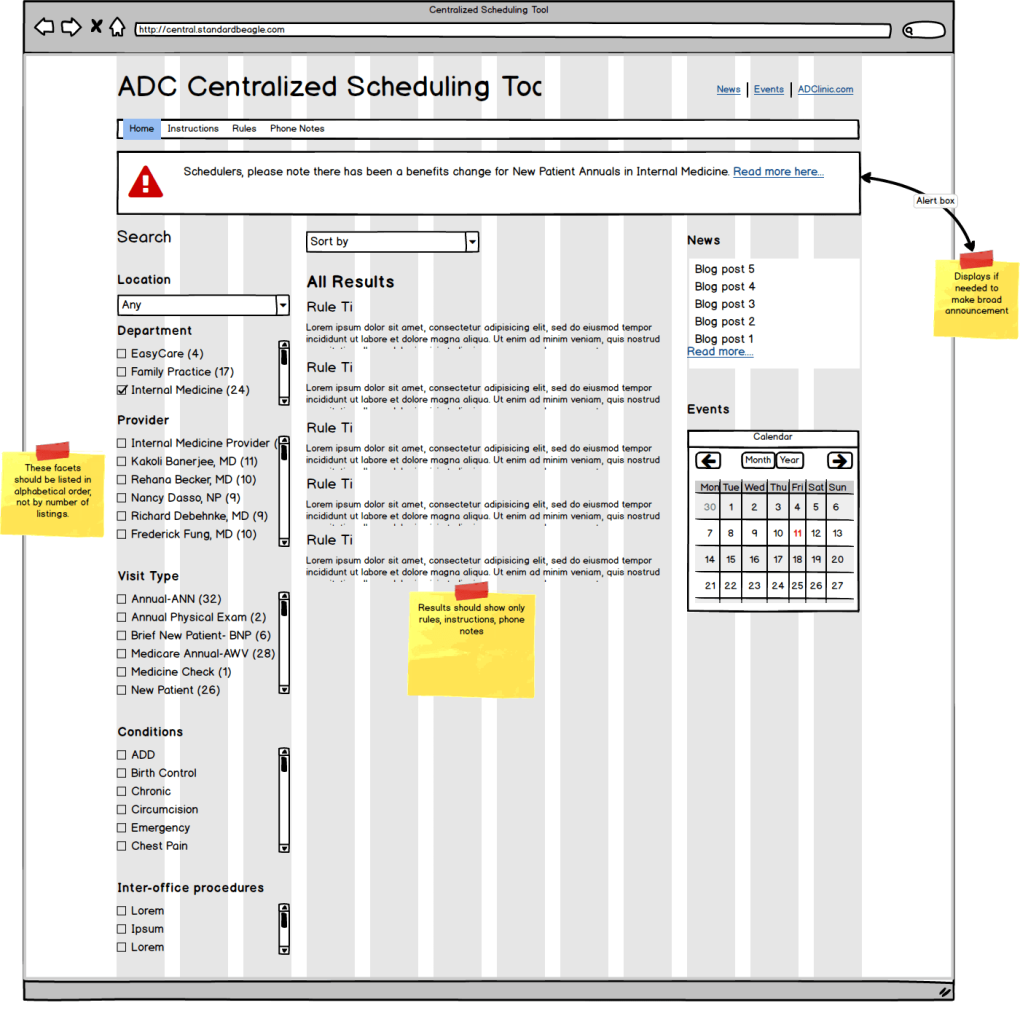Scheduling Tool for Health Clinic
Improving response time for schedulers
The Austin Diagnostic Clinic’s Centralized Scheduling section is responsible for taking patient phone calls and scheduling them for appointments with the majority of more than 150 physicians and mid-level practitioners who practice at ADC.
They faced an efficiency problem. They were using a manual process for keeping up with updates and rules from the doctors. As a result, their average time to schedule patients during a call was higher than their goal.
They needed a better way to manage patient scheduling.
How might we help ADC patients schedule appointments more quickly?
Project Approach
Through research and design we developed a website that would help the department keep information in a central location and improve response times.
Approach
Scope: This was a 12 week project to complete the solution. We were budgeted for one designer/researcher and one developer. While we were provided with access to the centralized scheduling team, we were not able to talk to patients because of HIPAA concerns.
It was important to the client that the department and managers be able to update the site information themselves. This is why we chose WordPress for our final implementation.
Research methods:
- Stakeholder interviews
- Observation
- Scheduler interviews
Outcomes
I learned the Centralized Scheduling department is responsible for taking patient phone calls and scheduling them with the majority of more than 150 physicians and mid-level practitioners who practice at ADC.
The staff handles hundreds of phone calls daily, and they are expected to quickly and efficiently schedule patients with the appropriate provider at the appropriate time.
I conducted observations of the staff at typically busy times during the day. We watched as managers and staff members answered incoming calls and scheduled appointments or re-routed patients to the right place.
Each manager explained their processes and allowed us to watch in real time so we could understand common issues and pain points.
Key Takeaways
- ADC’s departments and providers have a number of custom scheduling rules that Centralized Scheduling staff need to know and understand when scheduling patients.
- The clinic’s intranet was not updated frequently enough to keep up with the frequent scheduling changes. In order to keep track, Centralized Scheduling managers were tracking rules and schedules manually, with large notebooks of scheduling instructions. Some documents were hundreds of pages in length and finding information was highly inefficient.
- Because of the manual process, some of the information differed from staff member to staff member, which meant the information was not uniform. Phone calls were taking longer than expected and there had been complaints from departments and their staff if mistakes had been made.
Recommendations
Centralize information
All staff members needed to see a central source of information that could be updated frequently. An electronic method would be ideal in this situation. What we used would need to be updated by several managers with changes immediately visible to the staff. An intranet site would work well in this capacity.
Make the information searchable
Information needed to be accessed in seconds, rather than minutes. Because of the sheer amount of information, the information architecture should be cataloged in a searchable database, ideally in multiple ways, so that data is always at the user’s fingertips
Use a CMS with role-based access
In order to track changes and protect proprietary information, we felt a role-based access system would be essential. The data could be protected from anyone who did not have password access. In addition, user roles would allow users to have access to only those areas of the site that they needed. The site would keep a record of who had edited content on the site.
Wireframes
Simplicity was key for these frames. Users would need to find information quickly and easily, so it was important to keep the structure extremely simple with an emphasis on white space.

Impact
The research and designs were implemented as a website the client could maintain themselves.
Since the micro-site launched, it remains a critical part of the day-to-day operations at ADC Centralized Scheduling.
Based on feedback from other departments, the site was opened up to be viewed by ADC staff outside of Centralized Scheduling, and processes were put in place to request rule changes.
This increased transparency about scheduling practices and improved communication. Provider complaints have decreased significantly.
Lessons Learned
My favorite part of the project was conduction the observations.
Sitting with the schedulers and watching them work showed me over and over again the areas that needed to improve. It was a little overwhelming at first because the system itself was working against the schedulers.
But once I identified a solution for one part of the issue, it greatly improved the response time.
Business Inquiries:
[email protected]
Interested in working with me or my company? Standard Beagle is a UX agency providing UX strategy, user research, and product design.
Reach out through my business email and visit our website at standardbeagle.com.
